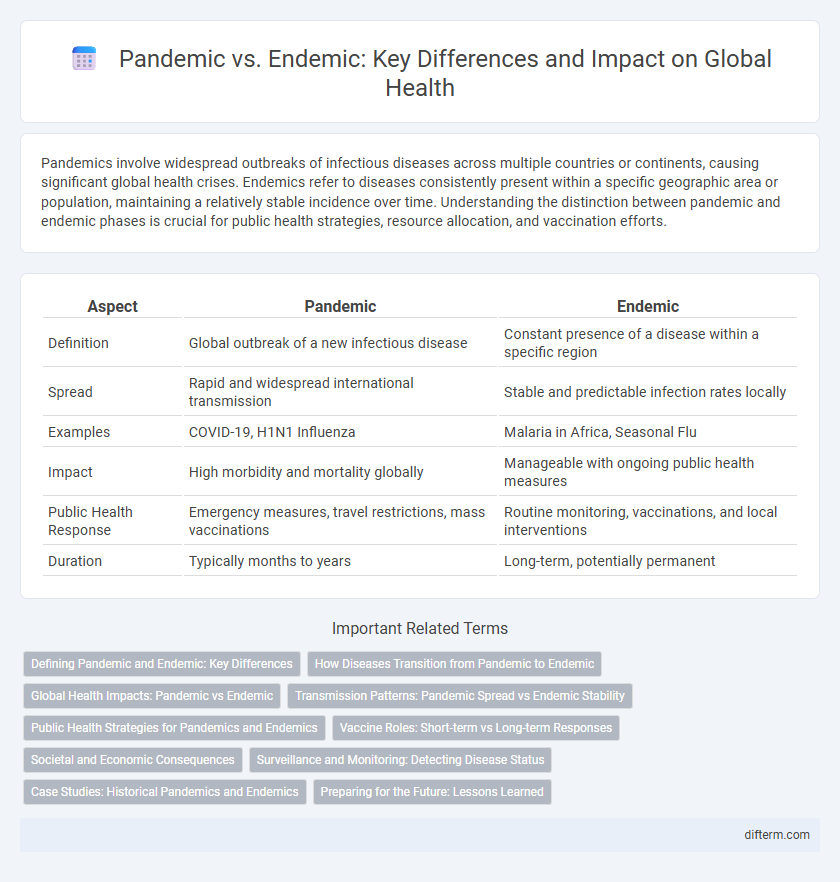Pandemics involve widespread outbreaks of infectious diseases across multiple countries or continents, causing significant global health crises. Endemics refer to diseases consistently present within a specific geographic area or population, maintaining a relatively stable incidence over time. Understanding the distinction between pandemic and endemic phases is crucial for public health strategies, resource allocation, and vaccination efforts.
Table of Comparison
| Aspect | Pandemic | Endemic |
|---|---|---|
| Definition | Global outbreak of a new infectious disease | Constant presence of a disease within a specific region |
| Spread | Rapid and widespread international transmission | Stable and predictable infection rates locally |
| Examples | COVID-19, H1N1 Influenza | Malaria in Africa, Seasonal Flu |
| Impact | High morbidity and mortality globally | Manageable with ongoing public health measures |
| Public Health Response | Emergency measures, travel restrictions, mass vaccinations | Routine monitoring, vaccinations, and local interventions |
| Duration | Typically months to years | Long-term, potentially permanent |
Defining Pandemic and Endemic: Key Differences
A pandemic is characterized by the widespread outbreak of a contagious disease affecting multiple countries or continents, often causing significant morbidity and mortality. In contrast, an endemic refers to the constant presence and usual prevalence of a disease within a specific geographic area or population, typically with predictable patterns. Understanding these key differences aids public health strategies in disease control and prevention.
How Diseases Transition from Pandemic to Endemic
Diseases transition from pandemic to endemic as populations develop widespread immunity through infection or vaccination, reducing the severity and spread over time. Public health measures and viral mutations also influence the stabilization of infection rates within specific regions or globally. Continuous surveillance and adaptive healthcare strategies are critical in managing this shift and minimizing long-term impacts.
Global Health Impacts: Pandemic vs Endemic
Pandemics cause widespread, rapid transmission of infectious diseases across multiple countries, overwhelming global health systems and disrupting economies due to high morbidity and mortality rates. In contrast, endemic diseases persist at a steady state within specific populations, allowing health systems to develop targeted, long-term management strategies that reduce severe outcomes. Understanding the differential global health impacts guides public health policies in resource allocation, surveillance, and vaccination programs to mitigate consequences effectively.
Transmission Patterns: Pandemic Spread vs Endemic Stability
Pandemic transmission patterns are marked by rapid, widespread outbreaks crossing multiple countries or continents, driven by high reproduction numbers and susceptible populations. Endemic diseases maintain a consistent presence within a specific geographic area, exhibiting stable transmission rates influenced by population immunity and environmental factors. Understanding these varying transmission dynamics is crucial for targeted public health interventions and resource allocation.
Public Health Strategies for Pandemics and Endemics
Public health strategies for pandemics prioritize rapid response measures such as widespread testing, contact tracing, and emergency vaccination campaigns to contain the fast-spreading pathogens. In contrast, endemic management emphasizes continuous surveillance, routine immunization programs, and community education to maintain control over persistent diseases. Both approaches require coordinated global and local health systems to optimize resource allocation and minimize morbidity and mortality.
Vaccine Roles: Short-term vs Long-term Responses
Vaccines play a crucial role in managing pandemics by rapidly reducing infection rates and preventing severe illness through mass immunization campaigns. In endemic scenarios, vaccines contribute to long-term disease control by maintaining herd immunity and minimizing outbreak frequency and severity. Continuous vaccine development and booster programs are essential to adapt to viral mutations and sustain population health resilience.
Societal and Economic Consequences
Pandemics cause widespread societal disruption by overwhelming healthcare systems, leading to increased mortality rates and strained public services. Economic consequences include sharp declines in global trade, massive unemployment, and long-term recession risks due to lockdowns and decreased consumer spending. In contrast, endemic diseases allow societies to adapt with stable healthcare responses and less severe economic impact as infection rates remain predictable and manageable.
Surveillance and Monitoring: Detecting Disease Status
Effective surveillance and monitoring systems are critical for detecting disease status in both pandemics and endemics, enabling timely identification of outbreaks and trends. Real-time data collection from healthcare facilities, laboratories, and community reports enhances the accuracy of infection tracking and supports targeted public health responses. Advanced technologies like genomic sequencing and AI-driven analytics improve detection of virus mutations and transmission patterns, facilitating informed decision-making in disease control efforts.
Case Studies: Historical Pandemics and Endemics
The 1918 Spanish Flu pandemic caused an estimated 50 million deaths worldwide, highlighting the rapid global spread of novel pathogens. In contrast, malaria remains endemic in tropical regions, with approximately 229 million cases annually, showcasing persistent localized transmission. Understanding these historical cases aids in developing targeted public health responses for future infectious disease management.
Preparing for the Future: Lessons Learned
Building resilient healthcare systems and investing in robust surveillance technologies are critical lessons learned from managing pandemics and transitioning to endemic phases. Strengthening global collaboration for data sharing and rapid response ensures timely detection and containment of emerging infectious diseases. Emphasizing public health education and vaccination campaigns prepares communities to effectively mitigate future health crises.
Pandemic vs Endemic Infographic

 difterm.com
difterm.com